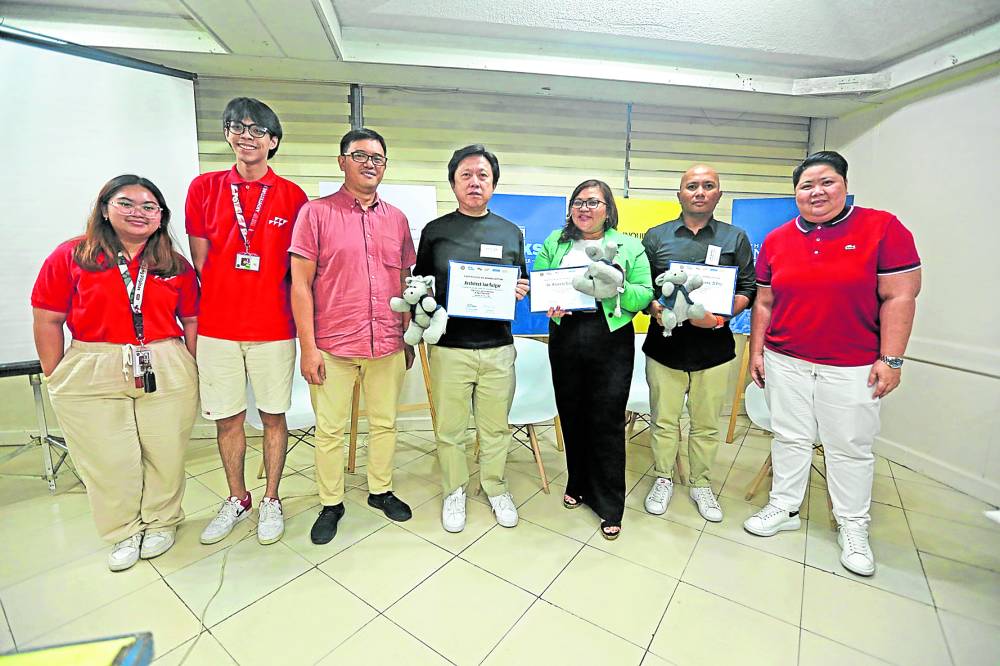
(From left) UP Diliman Arki Forum Executive Secretary Carmel Estepa, UP Diliman Arki Forum Vice Chairperson Jedrick Dimayuga, UP Diliman College of Architecture Assistant Dean Prof. Dan Villajuan, Architect Ian Fulgar, Dr. Pamela Cajilig, Prof. Nappy Navarra D. Eng, and Inquirer Property editor Tek Samaniego (Philippine Daily Inquirer Facebook page)
Architecture students from the University of the Philippines-Diliman recently gathered for an enlightening session at the Campus Talks event, a collaborative effort between Inquirer Property, the UP College of Architecture and UP Diliman Arki Forum.
The theme, “The Future of Architecture in the Philippines”, brought together a panel of speakers to explore ideas challenging traditional urban planning and design. The lineup included experts who presented topics like urban silence, cross-disciplinary collaborations, and the growing influence of artificial intelligence (AI) on the built environment.
Co-Founder and Curiosity Design Researcher, as well as Professorial Lecturer at UP College of Architecture, Dr. Pamela Cajilig, shared valuable insights on the topic ‘Cross-disciplinary Collaborations in Architecture for Climate Change’. (Philippine Daily Inquirer Facebook page)
Meditative urban spaces
Prof. Nappy Navarra opened the event with his talk, “The Quiet Place: Meditating in the City,” focusing on the importance of quietness in urban development. He emphasized that incorporating silent spaces into city planning can enhance mindfulness and mental well-being.
Navarra’s idea positioned tranquility as an absence of noise and an asset in creating more reflective and balanced urban environments. He argued that quietness in urban environments fosters a reflective state of mind, enhancing cognitive functions and stress reduction.
This notion aligns with trends in well-being that advocate for peaceful, meditative spaces in bustling cities.
Architect Ian Fulgar shared his expertise on artificial intelligence as a tool for creating future-proof and sustainable design. (Philippine Daily Inquirer Facebook page)
Climate-smart design
Dr. Pamela Gloria Cajilig presented her topic, “Cross-disciplinary Collaborations in Architecture for Climate Change.”
She stressed the significance of inclusivity and teamwork in designing climate-resilient spaces. By integrating expertise from various fields, Cahilig highlighted a path toward a more holistic approach to urban development that adapts to the challenges of climate change.
She emphasized the role of science and community engagement in sustainable architecture, while stressing the need for architecture beyond aesthetics, focusing on resilience and adaptability.
Professor Nappy Navarra D. Eng shared meaningful insights on the topic ‘The Quiet Place: Meditating in the City’. (Philippine Daily Inquirer Facebook page)
AI in architecture and beyond
The third speaker, Ar. Ian Fulgar, offered the event’s centerpiece, a talk on “Artificial Intelligence as a Tool in Creating Future-Proof and Sustainable Design.” Fulgar’s discourse shifted the discussion toward the impact of AI on architectural practice and the built environment in the Philippines, aligning seamlessly with the event’s futuristic theme.
Fulgar opened by distinguishing between AI and artificial general intelligence (AGI) to clarify their roles and potential in architecture. He emphasized the value of training AI agents, comparing supervised and unsupervised datasets to highlight how these technologies will redefine architectural workflows.
He further illustrated the transition from traditional Building Information Modeling (BIM) to AI-assisted designs, underscoring that this evolution is more than a technological shift but are paradigm changes in how architects approach creativity and problem-solving. By integrating AI into the design process, architects can generate models that are more efficient, logical, and tailored to specific performance criteria.
Fulgar showcased the potential of AI tools already transforming the Architecture, Engineering, and Construction (AEC) industry, such as machine learning algorithms that predict structural integrity or software that optimizes material usage in real time.
He also painted a vivid picture of a utopian architectural landscape where AI, sensors, and 3D-printed robotics converge to create buildings and urban environments that are responsive, adaptable, and inherently sustainable.